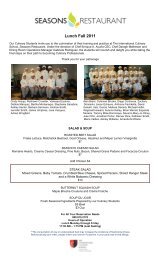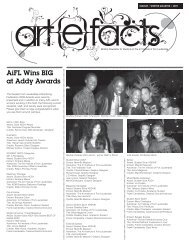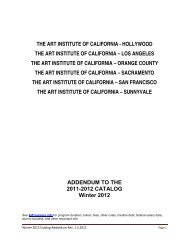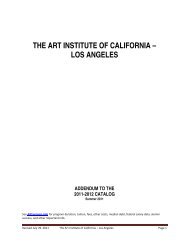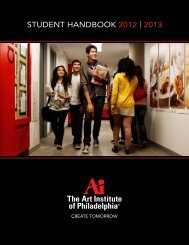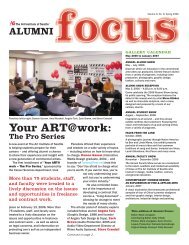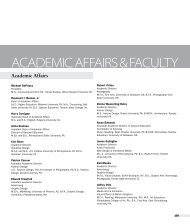2009 - 2010 Catalog - The Art Institutes
2009 - 2010 Catalog - The Art Institutes
2009 - 2010 Catalog - The Art Institutes
You also want an ePaper? Increase the reach of your titles
YUMPU automatically turns print PDFs into web optimized ePapers that Google loves.
course that must be completed before a<br />
student is allowed to take another course.<br />
For example, the prerequisite for English<br />
II is English I. That means a student must<br />
successfully complete English I before<br />
being allowed to enroll in English II. <strong>The</strong>se<br />
prerequisite courses are indicated in the<br />
course descriptions in the catalog.<br />
Course numbering: Each course has a 6<br />
digit reference code. <strong>The</strong> first two digits<br />
of the code refer to the program for that<br />
course. For example, in GE2411, the<br />
GE represents General Education. For a<br />
complete list of the program abbreviations<br />
refer to the the program curriculum<br />
listings in this catalog. <strong>The</strong> following 4<br />
digits represent other information. <strong>The</strong><br />
first number designates the level of the<br />
course, the range is 1-4. A number of 1 or<br />
2 represent lower level courses intended to<br />
be taken within the students first academic<br />
year and a half. Numbers 3 or 4 represent<br />
upper-level courses that are intended for<br />
student to take in the second half of their<br />
education. While a course may not have<br />
a prerequisite the level of the course does<br />
indicate a level of academic preparedness<br />
a student should have before taking<br />
a course. <strong>The</strong> Academic Director or<br />
Academic Advisor may use their best<br />
judgment in determining if a student has<br />
completed an adequate percentage of<br />
lower level course work before allowing<br />
registration for upper level courses. <strong>The</strong><br />
3rd number of the course code is the<br />
number of credits the course is. <strong>The</strong> last<br />
2 digits of the course code are used to<br />
identify the specific classes.<br />
ACADEMIC CALENDAR<br />
<strong>The</strong> <strong>Art</strong> <strong>Institutes</strong> International Minnesota<br />
runs on a quarter calendar. Quarters are 11<br />
weeks in length, and are designated Fall,<br />
Winter, Spring and Summer. It is expected<br />
that students will maintain their enrollment<br />
throughout four quarters. Breaks are<br />
scheduled between each term. <strong>The</strong> normal<br />
schedule allows three-week breaks in<br />
study following Fall and Spring Quarters,<br />
and one-week breaks in study following<br />
Winter and Summer Quarters. Students<br />
choosing to take a term off are put in an<br />
“out of school” status, which has financial<br />
aid implications.<br />
A current academic calendar is located<br />
on the Registrar’s website at<br />
http://www.aim.aiiresources.com/<br />
eventscalendar/=741&Itemid=203.<br />
COURSE LOAD<br />
Based on credit hours, course load is<br />
defined as follows:<br />
• Full-load: <strong>The</strong> student is enrolled<br />
in 16 credit hours in an academic<br />
quarter<br />
92<br />
• Full-time: <strong>The</strong> student is enrolled<br />
in 12 credit hours or more in an<br />
academic quarter<br />
• Half-time: <strong>The</strong> student is enrolled in 8<br />
credit hours in an academic quarter<br />
• Less than half time: <strong>The</strong> student<br />
is enrolled in 4 credit hours in an<br />
academic quarter<br />
REPEATING COURSES<br />
Every course for which a student receives<br />
a grade of “F,’’ “W,’’ or “WF” must be<br />
repeated and completed with a passing<br />
grade prior to his or her final quarter<br />
of study. A grade of “C-“ or below in<br />
program milestone/capstone courses, indicates<br />
that the courses must be repeated<br />
and completed with a passing grade, prior<br />
to his or her final quarter of study. <strong>The</strong><br />
original grade/code and the subsequent<br />
passing grade(s) will remain on the record<br />
for reference purposes. However, when a<br />
course is successfully repeated, only the<br />
passing grade (not the original grade/code)<br />
will be computed in the grade point average.<br />
Tuition is charged for repeated courses.<br />
When a final course grade has been<br />
established and recorded in the student’s<br />
record, the grade may only be changed<br />
with the approval of the Academic Director<br />
and the Dean of Academic Affairs.<br />
Note: Transitional courses may only be<br />
attempted three times. If the student fails<br />
to complete the transitional course within<br />
three attempts they will be academically<br />
dismissed from the college.<br />
TRANSITIONAL STUDIES<br />
Transitional Mathematics and English<br />
courses are designed to re-acquaint students<br />
with basic Mathematics and English<br />
skills needed to succeed in all coursework<br />
at <strong>The</strong> <strong>Art</strong> <strong>Institutes</strong> International Minnesota.<br />
<strong>The</strong> goal of the Transitional courses<br />
is to offer the opportunity to build on English<br />
and Mathematical skills and prepare<br />
students for college level requirements<br />
in English and Mathematics. Transitional<br />
courses do not count toward degree completion,<br />
yet are required for all students<br />
who do not achieve the standardized<br />
placement scores for college-level English<br />
and Mathematics. Students are required<br />
to complete the transitional courses with a<br />
“C” or higher. Students must successfully<br />
complete the transitional courses with no<br />
more than three attempts. Non-completion<br />
of a transitional course in three attempts<br />
is grounds for academic termination.<br />
Students must successfully complete such<br />
courses in order to progress in the program.<br />
Transitional Studies course credits<br />
do not count towards the total number of<br />
credits for graduation nor do they count<br />
in the CGPA; however, they do count in<br />
determining the maximum time frame and<br />
the incremental completion rate.<br />
CHANGE OF PROGRAM<br />
A student may change his or her program<br />
at any point of his or her enrollment while<br />
in good academic standing. Students<br />
will be allowed only one change of major.<br />
Grades from courses taken in a program<br />
at the same <strong>Art</strong> Institute, if applicable to<br />
a transfer program, will be recorded and<br />
will affect the student’s CGPA. In cases in<br />
which a student has graduated from the<br />
college in one major, and then subsequently<br />
begins work in a different major,<br />
grades used in the CGPA of the previous<br />
program will not be applied to the<br />
student’s new program CGPA calculation.<br />
Those courses transferred will apply to<br />
the new program of study for ICR purposes<br />
only.<br />
<strong>The</strong> maximum allowable timeframe shall<br />
be calculated as the total number of<br />
credits in the program minus the number<br />
of credits applied to the new program of<br />
study multiplied by 150%. Example: If a<br />
student transfers 36 credits to a new major<br />
consisting of 180 credits, the calculation<br />
would be 180 - 36 = 144 X 150% = 216<br />
credits. Second example: If a student<br />
earned 36 credits in the original major<br />
that are applicable to the new major,<br />
but transfers 48 credits due to repeating<br />
failed classes, then the maximum allowable<br />
timeframe is reduced to 198 credits.<br />
Courses that apply to the second program<br />
of study will be recorded as earned credit<br />
and will affect the student’s CGPA. For ICR<br />
purposes, earned credit applied to the new<br />
program will reduce the total number of<br />
credits that must be attempted within the<br />
program. <strong>The</strong>refore, the maximum allowable<br />
credits are one and one-half times the<br />
number of credits remaining to complete<br />
for graduation. Students who change programs<br />
and students who change session<br />
times within the same program must sign a<br />
new program enrollment form, which must<br />
be filed in the student’s academic file.<br />
LEAVES AND<br />
EXTERNAL TRANSFERS<br />
TRANSFERRING TO<br />
NOTHER EDMC SCHOOL<br />
If a student wishes to transfer to another<br />
college within the EDMC network of<br />
schools they should contact the Assistant<br />
Director of Readmissions at the college<br />
they intend to attend. <strong>The</strong> Assistant Director<br />
of Readmissions will assist the student<br />
in transferring to the new college. <strong>The</strong> Student<br />
should also contact their Academic<br />
Advisor at <strong>The</strong> <strong>Art</strong> <strong>Institutes</strong> International<br />
Minnesota to discuss the transfer and<br />
complete a Change of Enrollment form.



